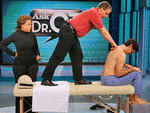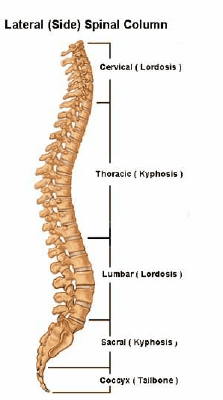
Lordosis
Lordosis is defined as an excessive inward curve of the spine. It differs from the spine's normal curves at the cervical, thoracic, and lumbar regions, which are, to a degree, either kyphotic (near the neck) or lordotic (closer to the low back). Lordosis is often also called swayback or sway back.
The Knock On Effects Of Lordosis
Lordosis or swayback is a muscle imbalance combined with bad posture . The spinal imbalance affects the arms, legs, head pelvis, and rib cage as well as the rest of the body.
- 80% percent of all Lordosis cases have decreased heart, lung, and cardiovascular capacity. The body’s diaphragms are affected by the side bends of Lordosis or swayback.
- Lordosis or swayback causes lower back pain. Your abs & lower back stabilize your torso. Lordosis stretches your abdominal muscles, making them weak. Your lower back now has to do all the work, which results in fatigue & pain.
- Lordosis or swayback causes loss of strength. The glutes are one of your strongest muscles. With lordosis you only use your lower back & hamstrings to lift the weight. This isless efficient than using all hip muscles. You need to involve your glutes.
- A person who has Lordosis or swayback tends to suffer from headaches, insomnia, back pain, shallow breathing and sciatica which are all brought about by having Lordosis' characteristically elongated musculature on one side of their bodies and a shortened musculature on the other side of their bodies.
The Rolf Approach To Lordosis
Lordosis or swayback is a clinical term that identifies spinal exaggerations. In using the terms, we fall into the trap of understanding the imbalance as solely or mostly confined to the spine. But Rolfing views lordosis or swayback is a structural imbalance of the body as a whole.
Rolfing is a systematic programme of postural repatterning that seeks to bring your body back into alignment. Thus Rolfing continuously seeks out a dynamic, creative balance in your body that is quite different from holding it in one rigid postural position.
How Rolfing Treats
Lordosis
As the lordosis patient walks into the Rolfing Clinic, the Rolfer assesses the person’s posture and structural balance to ascertain the extent of the imbalance i n the feet, knees or pelvic area as well as gauging any other outward indicators of lordosis symptoms..
Fundamentally, Rolfing treats Lordosis or swaybck by stretching the tight muscles and strengthening the weak ones through myofascial release. Myofascial release is a form of soft tissue therapy in Rolfing that works on the tissue located between the skin and the underling structure of muscle and bone to provide pain relief, increase your range of motion and balance your body for optimum posture.
Thus Rolfing realigns and lengthens the shortened connective tissue that wraps around the muscles. In other words, it de-rotates this connective tissue. This improves your posture and movement, which can help reduce or eliminate the headaches, back pain, shoulder and neck pain that is brought on by lordosis or swayback.
The Rolfing technology takes the whole being into consideration when exploring how to work with each individual, seeing them for more than just the product of their environmental conditioning. Certified Rolfing has the capacity to release, realign, and balance the whole body of a Lordosis patient.
How Rolfing Treats Lordosis
As the lordosis patient walks into the Rolfing Clinic, the Rolfer assesses the person’s posture and structural balance to ascertain the extent of the imbalance in the feet, knees or pelvic area as well as gauging any other outward indicators of lordosis symptoms..
Fundamentally, Rolfing treats Lordosis or swaybck by stretching the tight muscles and strengthening the weak ones through myofascial release. Myofascial release is a form of soft tissue therapy in Rolfing that works on the tissue located between the skin and the underling structure of muscle and bone to provide pain relief, increase your range of motion and balance your body for optimum posture.
Thus Rolfing realigns and lengthens the shortened connective tissue that wraps around the muscles. In other words, it de-rotates this connective tissue. This improves your posture and movement, which can help reduce or eliminate the headaches, back pain, shoulder and neck pain that is brought on by lordosis or swayback.
The Rolfing technology takes the whole being into consideration when exploring how to work with each individual, seeing them for more than just the product of their environmental conditioning. Certified Rolfing has the capacity to release, realign, and balance the whole body of a Lordosis patient.
lordosis
|

Certified Rolfer®
Vincent Lee
Rolfing was featured in


“Two Hands” 2007 Academy Award. Nominated for documentary film.

Andrew Weil, M.D.
“Good Morning From Dr. Weil.com” An on-line daily newsletter published a health news brief June 25, 2004--“Tip: Is Your Posture Bad? Today’s Tip-Rolfing."
